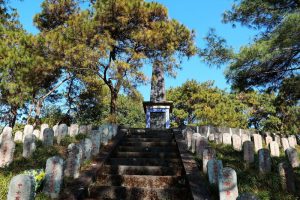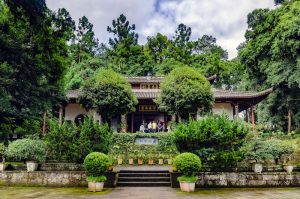The Graveyard of the National Heroes in Tengchong County, Baoshan

Chinese Name: 腾冲国殇墓园
Chinese Pinyin: Teng Chong Guo Shang Mu Yuan
English Name: The Graveyard of National Heroes
Type: cemetery, memorial hall, historical architecture
Opening Hours: 09:00-18:00 from Tuesday to Sunday
Recommended Visiting Hours: 2-3hours
Ticket: free
Area: about 53,000 square meters
Location: No.2 Taiji Community, Tengyue Town, Tengchong City
Graveyard of the National Heroes
The Graveyard of the National Heroes (国殇墓园) constructed to honour the martyrs at the battle of recovering Tengchong lies in the west of the county seat at about 1 kilometre’s distance. The construction was started in 1944 and completed on the 7th of July, 1945. It was Li Genyuan who called for the construction of the memorial graveyard. Covering over 10,000 square meters, the main structures are the memorial tower, the martyrs’ tombs, the memorial hall and the gate.
Why is Graveyard of the National Heroes so special?
The Graveyard of the National Heroes is the oldest and largest National Army Anti-Japanese Martyrs Cemetery established in the country. In 1996, it was listed by the State Council as a “National Key Cultural Relics Protection Unit”. On December 2, 2017, it was selected as the second batch of“Chinese architectural heritage of 20th century”.
Where is Graveyard of National Heroes?
It lies in the west of the county seat at about 1 kilometer’s distance.
Distance from main attractions
380 meters from Dieshuihe River Scenic Spot
9.7 km from the Rehai Hot Spring
3.7 km from Heshun Ancient Town
4.2 km from Yiluo Ancient Town
How to get to Graveyard of National Heroes?
The Graveyard of National Heroes is situated in urban area. It is convenient for travelers to get in and get around. Travelers can get to rent a car or take taxi to it. Otherwise, travelers can take the No.4 and No.6 buses and get off in the Graveyard of National Heroes.

History
The pine and cypress trees densely planted on the mountain slope add to the solemn tranquility of the site. At the completion of the cemetery, Chiang Kai-shek penned an inscription meaning “The just cause for which they shed their blood lasts forever and ever.” Yu Youren wrote the title of the cemetery. Li Genynan praised the martyrs as “National Heroes.” Other high-ranking military officers of the Kuomin tang, such as He Yingqin, Wei Lihang, Huo Kwizhang, Zhou Fucheng, Qiu Hanqian and Gu Baoyu, all wrote inscriptions for the martyrs. The cemetery is placed under the province’s protection.
Though far away from the central China, Tengchong and Longling counties in the west of Yunnan province have been gloriously remembered into the Chinese history, especially for the WW II. In May 1942, the border of West Yunnan was coveted by the Japanese invaders who had already occupied Burma on the other side of the Nujiang River. When most China’s territories on the west bank of the river were lost into the Japanese hands, the Yunnan-Burma Road, which was then the only international passage in the Great Rear Area of China, was thoroughly cut off. In May 1944, the China Expeditionary Army (CEA) launched the counterattack in order to recapture the lost lands, and most importantly to ensure that international military supplies can reach China via the Yunnan-Burma Road. After 43-day fierce battle, came the victory–but with great toll. Six divisions of Chinese military (including the CEA) managed to cross over the Nujiang River and fought bloody battles with the Japanese soldiers.

With the aid of the Alliance, Tengchong was eventually retrieved. However, the cost was big: the toll of Chinese soldiers/officers hit 9,168 and the Alliance 19. The grave yard Sitting at the foot of Laifeng Mt, Tengchong County, the Martyrs’ Grave Yard was first constructed in January 1945 to enshrine those sacrificed in the WW II. It covers about 53,000 sq meters, and includes such sights as the Loyalty Shrine, the martyrs’ graves, the Monument and the Museum.
Li Genyuan
Li Genyuan(李根源), from Tengchong, was a famous general of the Yunnan Army and a member of the Government. In the year of 1923, he was appointed to the post of premier and minister of agriculture and commerce. During the War of Resistance, he was Ombudsman of Yunnan and Guizhou. After western Yunnan was invaded by the Japanese in 1942, Li insisted on blocking the enemies on the west of Nujiang River and volunteered to fight enemies in spite of his old age. His famous “A Letter to The People of Western Yunnan” enormously boosted the fighting will of Chinese soldiers and civilians.
What to See
The Cemetery consists of three parts: the Memorial Square, the Monument, and the Hero Tomb.

According to the information of the official website of the cemetery in August 2017, there are 2 exhibition halls with an exhibition area of 650 square meters and 141 pieces of anti-war objects. The exhibition adopts the concept of modern museums, sound, light and electricity. The contents of the exhibition are divided into five parts to memorial the heroes and the war.
The most impressive part of the cemetery is the small tombstones around the monument. The tombs of the martyrs are built around the tower radially. The tower is the center of the garden. There are eight fan-shaped cemeteries. From top to bottom, the tombstones are neatly arranged according to the sequence of the original combat troops and the title. The monument is engraved with the rank and name of the martyrs.
Nearby Attractions
Heshun Ancient Town is located in 4 kilometers southwest of Tengchong County. ‘Heshun’ meas peaceful and great life of Heshun people. With a population of more than 6000, the overseas Heshun people total more than 12000 hence the frame ‘ The Home of Overseas Chinese’. Enjoying long history and civilization of more than 600 years, there is around 1000 traditional folk residences in Heshun, 100 of which is built in Qing Dynasty, known as the ‘Living Fossil of Chinese Ancient Architecture’. You can not only appreciate the romantic charm of Hui-style architecture but also find out some western elements in Heshun Ancient Town. The Chinese and Western style mix together and show a unique charm.
The Big Boiling Bowl is one of the main attractions in Tengchong County that is accessible from Heshun village. The temperature reaches up to 97 degrees in some of the springs. The locals even offer eggs cooked in the hot springs. The water contains high levels of minerals that provide a lot of benefits for the skin.
Useful Travel Tips
Tengchong enjoys the favorable climate, so it is recommended to travel in Tengchong all seasons.
The Graveyard of National Heroes opens from Tuesday to Sunday. It was closed on Monday.
Respect the passed heroes.

 7 Days GolfingTour
7 Days GolfingTour
 8 Days Group Tour
8 Days Group Tour
 8 Days Yunnan Tour
8 Days Yunnan Tour
 7 Days Shangri La Hiking
7 Days Shangri La Hiking
 11 Days Yunnan Tour
11 Days Yunnan Tour
 6 Days Yuanyang Terraces
6 Days Yuanyang Terraces
 11 Days Yunnan Tour
11 Days Yunnan Tour
 8 Days South Yunnan
8 Days South Yunnan
 7 Days Tea Tour
7 Days Tea Tour
 8 Days Muslim Tour
8 Days Muslim Tour
 12 Days Self-Driving
12 Days Self-Driving
 4 Days Haba Climbing
4 Days Haba Climbing
 Tiger Leaping Gorge
Tiger Leaping Gorge
 Stone Forest
Stone Forest
 Yunnan-Tibet
Yunnan-Tibet
 Hani Rice Terraces
Hani Rice Terraces
 Kunming
Kunming
 Lijiang
Lijiang
 Shangri-la
Shangri-la
 Dali
Dali
 XishuangBanna
XishuangBanna
 Honghe
Honghe
 Kunming
Kunming
 Lijiang
Lijiang
 Shangri-la
Shangri-la
 Yuanyang Rice Terraces
Yuanyang Rice Terraces
 Nujiang
Nujiang
 XishuangBanna
XishuangBanna
 Spring City Golf
Spring City Golf
 Snow Mountain Golf
Snow Mountain Golf
 Stone Mountain Golf
Stone Mountain Golf













